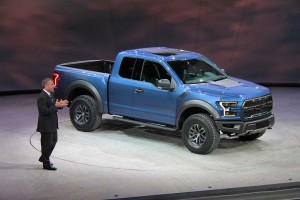
Ford President Joe Hinrichs helps unveil the new Ford F-150 Raptor during the 2015 Detroit Auto Show.
Though Ford Motor Co. has ballyhooed the benefits of the aluminum used to build its 2015 F-150 pickup, don’t expect to see the automaker start building passenger cars out of the lightweight metal, cautioned a top executive.
The benefits just aren’t as competitive when used on lighter vehicles, stressed Joe Hinrichs, Ford’s President of the Americas, during an appearance at an annual industry confab in Detroit.
“You don’t get those same benefits to a consumer on a car side,” he explained, adding that, “truck buyers will pay for more capability. Car buyers will pay for better fuel economy, but there’s other ways to get fuel economy in a car.”
Facing stiff new emissions and fuel economy mandates, automakers like Ford are struggling to find ways to improve the efficiency of their vehicles. They’re adopting advanced powertrains and alternate fuels, adopting more aerodynamic designs, and putting a premium on “lightweighting.”
(Ford GT, Buick Avenir take top honors in design awards at Detroit Auto Show. Click Herefor more.)
Aluminum is quickly becoming an alternative to traditional steel. But while a few luxury manufacturers – notably Audi and Jaguar Land Rover – have used the lightweight metal for vehicle bodies and chasses, it has had more limited use in mainstream vehicles, usually for things like hoods or trunk lids.
Ford decided to gamble on using aluminum far more extensively with the complete remake of its 2015 F-150, the most popular version of its F-Series pickup line-up which accounts for almost 20% of total North American Ford sales, Hinrich noted earlier in the week. The second-largest Detroit maker has retooled both of its F-150 plants to handle the new vehicle, as aluminum requires costly manufacturing changes.
Ford is betting the payoff is worth it. The switch to aluminum helped it shave as much as 750 pounds off the new truck, and that has led to a notable improvement in fuel economy. But at a time when gas is as cheap as it has been in over half a decade, the maker’s marketing is putting the primary emphasis on durability and capability, two critical issues for pickup buyers prone to putting their vehicles through plenty of abuse.
(Verizon wants to connect your car, will offer aftermarket safety and security suite that can even diagnose engine problems. Click Here for details.)
Ford has long considered ways to use aluminum, coming close to building a sedan model for Lincoln, codenamed DEW20, over a decade ago. In the end, the challenges of manufacturing, as well as the significantly higher costs for the metal, led it to stick with steel.
The steel industry, meanwhile, has been developing new, high- and ultra-high-strength alloys that make the business case for aluminum harder to justify, Ford insiders have told TheDetroitBureau.com.
So, at least for now, Ford seems likely to stick with limited body panel applications, while also using aluminum for engine blocks, suspension and other components.
Aluminum is facing competition not only from new steel alloys but also from other alternative materials. On Monday, Ford announced it would join up with chemical giant Dow to work on new ways to mass produce super-light carbon fiber – a material that, to many in the industry, is the Holy Grail for lightweighting.
Until now, carbon fiber and related variants have been phenomenally expensive to produce and use in vehicles, largely limiting their application to race cars and ultra-exotic vehicles from the likes of Ferrari and Lamborghini. But that’s beginning to change.
BMW has partnered in a bi-continental manufacturing project that will soon become the world’s largest maker of carbon fiber-reinforced composites, or CFRP. It is using the material for the bodies of its new i3 and i8 battery cars and is expected to work it down into its more mainstream line-up.
Ford will make use of both aluminum and carbon fiber in the new GT ultracar it debuted at the North American International Auto Show on Monday, but production is expected to be measured in the 100s of vehicles, with the price running well into six figures.
(Click Here to check out Ford’s new GT supercar.)

Helium filled bladders in the upper wheel wells should be a relatively cheap and effective counter to gravity. Ford can name it the F-150 Moon Rover.
Making the truck weigh less does not change the truck’s mass and momentum.
Lighter weight is always useful for improving mpg but it is not a silver bullet. A vehicle must be completely redesigned and engineered when using aluminum or other light weight materials compared to using steel. The jury is still out on the new F-150 as far as durability and longevity are concerned. It will take 5+ years to see if this experiment is practical.
What the automobile media is so quick to forget that ford through development programs 25 years ago showed Jaguar and Land Rover along with volvo and aston martin along with technical savey how to manufacturer components. Gotta keep that branding straight. Forget the idea a india company could have R & D like direct injection the first year they start making the vehicles. Gotta keep the oem media spins how the industry really works.